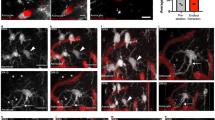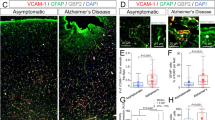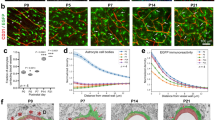Abstract
Astrocytes in the central nervous system have physiologically important roles in the response to brain injury 1, 2 . Brain damage results in disruption of the blood–brain barrier (BBB), producing detachment of astrocyte endfeet from endothelial cells 3 . The resultant leakage of serum proteins from loosened tight junctions between endothelial cells produces brain edema. At the same time, reactive astrocytes migrate to the injured area, where they proliferate and produce extracellular matrix 4, 5, 6 , thereby reconstituting the BBB. As astrocytes are known to express angiotensinogen 7, 8 , which is the precursor of angiotensins (AI to AIV), we have investigated a possible functional contribution of angiotensinogen or one of its metabolites to BBB reconstitution. The astrocytes of angiotensinogen knockout mice had very attenuated expression of glial fibrially acidic protein and decreased laminin production in response to cold injury, and ultimately incomplete reconstitution of impaired BBB function. Although these abnormalities were rescued by administration of AII or AIV, the restoration of BBB function was not inhibited by AII type 1 and 2 receptor antagonists. These findings provide evidence that astrocytes with angiotensins are required for functional maintenance of the BBB.
This is a preview of subscription content, access via your institution
Access options
Subscribe to this journal
Receive 12 print issues and online access
$209.00 per year
only $17.42 per issue
Buy this article
- Purchase on Springer Link
- Instant access to full article PDF
Prices may be subject to local taxes which are calculated during checkout




Similar content being viewed by others
References
Nieto-Sampedro, M., Saneto, R.P., De Vellis, J. & Cotman, C.W. The control of glial populations in brain: Changes in astrocyte mitogenic and morphogenic factors in response to injury. Brain Res. 343, 320–328 (1985).
Norenberg, M.D. Astrocyte responses to CNS injury. J. Neuropathol. Exp. Neurol. 53, 213–220 ( 1994).
Janzer, R.C. & Raff, M.C. Astrocytes induce blood–brain barrier properties in endothelial cells. Nature 325 , 253–257 (1987).
Ludwin, SK. Reaction of oligodendrocytes and astrocytes to trauma and implantation. Lab. Invest. 53, 20 –30 (1985).
Laywell, E.D. et al. Enhanced expression of the developmentally regulated extracellular matrix molecule tenasin following adult brain injury. Proc. Natl. Acad. Sci. USA 89, 2634–2638 (1992).
Reier, P.J. in Cell Biology and Pathology of Astrocytes (ed. Waxman, S.G.) 263 –324 (Academic, Orlando, Florida 1986 ).
Stornetta, R.L., Hawelu-Johnson, C.L., Guyenet, P.G. & Lynch, K.R. Astrocytes synthesize angiotensinogen in brain. Science 242, 1444–1446 (1988).
Milsted, A., Barna, B.P., Ransohof, R.M., Brosnihan, K.B. & Ferrario, C.M. Astrocyte cultures derived from human brain tissue express angiotensinogen mRNA. Proc. Natl. Acad. Sci. USA 87, 5720–5723 ( 1990).
Tanimoto, K. et al. Angiotensinogen-deficient mice with hypotension. J. Biol. Chem. 269, 31334–31337 (1994).
Sugiyama, F. et al. Speedy backcrossing through in vitro fertilization, using pre-pubertal superovulation and neonatal death dependent on genetic background in angiotensinogen-deficient mice. Lab. Anim. Sci. 47, 545–548 (1997).
Chan, P.H., Longar, S. & Fishman, R.A. Protective effects of liposome-entrapped superoxide dismutase on posttraumatic brain edema. Ann. Neurol. 21, 540–547 (1987).
Hama, H. et al. Role of endothelin-1 in astrocyte responses after acute brain damage. J. Neurosci. Res. 47, 590– 602 (1997).
Liedtke, W. et al. GFAP is necessary for the integrity of CNS white matter architecture and long-term maintenance of myelination. Neuron 17 , 607–615 (1996).
Goldstein, G.W. & Betz, A.L. The blood–brain barrier. Sci. Am. 255, 70– 83 (1986).
Le-Prince, G., Fages, C., Rolaand, B., Nunez, J. & Tardy, M. DBcAMP effect on the expression of GFAP and of its encoding mRNA in astroglial primary culture. Glia 4, 322–326 (1991).
Eng, L.F. & Ghirnikar, R.S. GFAP and astrogliosis. Brain Pathol. 4, 229–237 (1994).
Wright, J.W. et al. The angiotensin IV system: functional implications. Front. Neuroendocrinol. 16, 23–52 (1995).
Roberts, K.A. et al. Autoradiographic identification of brain angiotensin IV binding sites and differential c-Fos expression following intracerebroventricular injection of angiotensin II and IV in rats. Brain Res. 682, 13–21 (1995).
Miller-Wing, A.V., et al. Central angiotensin IV binding sites: distribution and specificity in guinea pig brain. J. Pharmacol. Exp. Ther. 266, 1718–1726 (1993).
Moeller, I. et al. Distribution of AT4 receptors in the Macaca fascicularis brain. Brain Res. 712, 307– 324 (1996).
De Oliveira, A.M., Viswanathan, M., Heemskerk, F.M.J. & Saavedra, J.M. Expression of a novel angiotensin II receptor subtype in gerbil brain. Brain Res. 705, 177–187 (1995).
Shibouta, Y. et al. Pharmacological profile of a highly potent and long-acting angiotensin II receptor antagonist, 2-ethoxy-1-[[2'-(1H-tetrazol-5-yl)biphenyl-4- yl]methyl]-1H-benzimidazole-7-carboxylic acid (CV-11974), and its prodrug (+/-)-1- (cyclohexyloxycarbonyloxy)-ethyl 2-ethoxy-1-[[2'-(1H-tetrazol-5-yl)biphenyl-4-yl]methyl]-1H-benzimidazole-7-carboxylate (TCV-116). J. Pharmacol. Exp. Ther. 266, 114–120 (1993).
Dudley, D.T. et al. Subclasses of angiotensin II binding sites and their functional significance. Mol. Pharmacol. 38, 370– 377 (1990).
Wright, J.W., Bechtholt, A.J., Chambers, S.L. & Harding, J.W. Angiotensin III and IV activation of the brain AT1 receptor subtype in cardiovascular function. Peptides 17, 1365– 1371 (1996).
Warnick, R.E. et al. Measurement of vascular permeability in spinal cord using Evans Blue spectrophotometry and correction for turbidity. J. Neurosci. Methods 58, 167–171 ( 1995).
Acknowledgements
This work was supported by grants from the 'Research for the Future' Program (The Japan Society for the Promotion of Science: JSPS―RFTF 97L00804), the Ministry of Education, Science, Sports, and Culture, The Mitsubishi Foundation, Uehara Memorial Foundation, Kanae Foundation of Research for New Medicine, The Inamori Foundation, The Asahi Glass Foundation, The Naito Foundation, The Mochida Memorial Foundation for Medical and Pharmaceutical Research, and The Nissan Science Foundation. We acknowledge our laboratory members for discussions and encouragement.
Author information
Authors and Affiliations
Corresponding author
Rights and permissions
About this article
Cite this article
Kakinuma, Y., Hama, H., Sugiyama, F. et al. Impaired blood–brain barrier function in angiotensinogen-deficient mice. Nat Med 4, 1078–1080 (1998). https://doi.org/10.1038/2070
Received:
Accepted:
Issue Date:
DOI: https://doi.org/10.1038/2070
This article is cited by
-
Renin–angiotensin system research: from molecules to the whole body
The Journal of Physiological Sciences (2019)
-
Renin angiotensin system and its role in biomarkers and treatment in gliomas
Journal of Neuro-Oncology (2018)
-
Association between an angiotensin-converting enzyme gene polymorphism and Alzheimer’s disease in a Tunisian population
Annals of General Psychiatry (2017)
-
Structure and functions of angiotensinogen
Hypertension Research (2016)
-
Genetic mouse models to study blood–brain barrier development and function
Fluids and Barriers of the CNS (2013)



